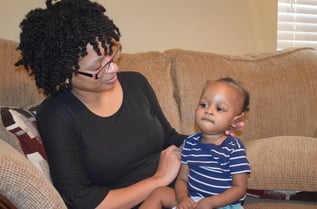
Play peek-a-boo with 9 month-old Jeremiah Licorish of Florence, and you’ll be rewarded with a huge grin that lights up both his and his mother’s faces.
But this family has been through the unthinkable over the past few months, with very few reasons to smile.
At first things were going well. Jeremiah was a happy, healthy newborn, doted on by his mother, Aneesa, and his three big brothers. But when Jeremiah was around 5 months old, Aneesa noticed changes in her youngest son’s development that worried her.
“He started to get weaker,” she shared. “He went from holding his head up to being more slumped and not having any neck control. He stopped reaching for things and wasn’t interested in eating – taking only two ounces of milk.”
His pediatrician wasn’t initially alarmed, thinking he was just being a lazy baby, but Aneesa knew some-thing wasn’t right. She began advocating for her son, first getting an appointment with McLeod Pediatric Rehab for physical therapy. “As soon as we got there, they said he needed more than physical therapy. He needed to see a neurologist and geneticist as soon as possible.”
Aneesa reached out to GGC through the Center’s website and received a call the next morning from Shannon Bell, Telemedicine and Genetic Services Coordinator in GGC’s Florence office. A typical appointment can take weeks or even months and for some families requires travel, but Bell was able to get Jeremiah scheduled with a telegenetics appointment close to home for the next day.
“Through telegenetics, we met Dr. Clarkson who examined every inch of Jeremiah – from how his arms were not moving, to his floppiness, and even his little webbed toes,” recalled Aneesa.
Katie Clarkson, MD, is a GGC clinical geneticist who provides telegenetics consultations for patients from her office in Pennsylvania. She considered several tests, but with a long list of possible diagnoses, she suggested whole exome sequencing, a diagnostic test looking for mutations in the coding regions of all 20,000 genes. Because of Jeremiah’s rapid regression, the test that typically takes 10 weeks for a result was fast-tracked by GGC’s Diagnostic Laboratory, and an answer came in fewer than three weeks.
Ray Louie, PhD, Assistant Director of GGC’s Molecular Laboratory, analyzed Jeremiah’s exome results using a new platform involving artificial intelligence (see p. 5), which quickly identified two changes in the TK2 gene. This gene is known to cause mitochondrial DNA depletion syndrome, type 2 also called TK2 deficiency.
TK2 deficiency is a disease that progresses quickly, causing muscle weakness, problems with chewing, swallowing, and breathing, loss of motor skills, and slowed mental development. Seizures and hearing loss can also develop.
Jeremiah is one of only 107 known cases of TK2 deficiency, and he’s the first African-American male to receive this diagnosis.
Bell recalls sharing the test results with the family, “We always dread giving bad news, but Aneesa was so thankful that we listened to her and found out so quickly. Through her tears, she just kept saying ‘thank you’. I couldn’t help but to cry with her.”
Aneesa was devastated with the diagnosis, but recalls that getting the rapid diagnosis “meant everything.”
“With a baby with a progressive disorder, time is of the essence. Getting the results in a timely manner and being able to connect to resources can literally save his life.”
Once the diagnosis set in, and “I stopped crying,” said Aneesa, “I decided to devote the rest of my life to helping with rare diseases.”
She began exhaustive research into this rare diagnosis, finding nothing but grim information online. Then she connected with another TK2 family and was introduced to Dr. Michio Hirano at Columbia University who is conducting a clinical trial on this rare disorder.
By the time a routine whole exome test result would have been reported, Jeremiah had a diagnosis, and he and Aneesa had made the long journey to New York City to enroll in Dr. Hirano’s study. Jeremiah is now receiving the study medication.
Aneesa’s hopes for the trial are that “this treatment turns into a cure and opens up avenues to help other people with rare diseases.”
“In Jeremiah’s case, we were able to mobilize the GGC team across the clinical and diagnostic divisions to get to the diagnosis as fast as possible, which was critically important for Jeremiah,” said Clarkson. “With our lab’s ability to expedite the results and through the use of telegenetics, Jeremiah was able to enroll in this trial earlier and with greater hope for an improved outcome.”
Aneesa recalls that during the appointment where the results were disclosed, there was a very determined black bird knocking on the window of the office. Aneesa found significance in what to most would have been a simple annoyance. To her this experience symbolized persistence even when faced with what seems to be an insurmountable barrier. She likened it to “being able to knock on the right door, and never giving up despite the barriers in your way.”
